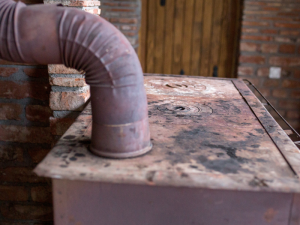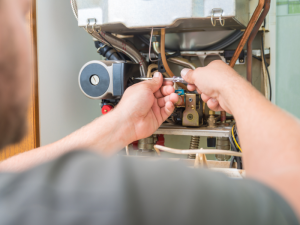Cold winters can be difficult to navigate without a functional HVAC system. Heat exchangers are one of the most widely used process equipment when it comes to heat regulation. They can either be used for cooling or heating. Heat exchangers are also the most essential components of HVAC systems. While they regulate the temperature in homes, they also play a huge role in energy conservation through the transfer of heat from one medium to another. But how do they work? What role do they play in ensuring that your HVAC system works optimally?
What is a heat exchanger?
A heat exchanger is a device that allows efficient and fast transfer of heat between different mediums. It can either be used to heat or cool one medium via another. While heat temperature can be decreased or increased via physical contact, heat exchangers involve the transfer of heat without physical contact. Rather, the process uses basic science to allow the flow of heat from hot mediums to cool mediums.
Let’s take a look at different types of heat exchangers and how they work.
1. Plate type heat exchangers
This is a type of heat exchanger that transfers heat from one medium to another through identical thin plates either made of stainless steel or titanium. The thin plates are held together using gasket material of asbestos fiber and rubber. The plates are also compact, which gives them the advantage of variable capacity. Plate type heat exchangers consist of six parts: frame plate, guide bar, support post, pressure plate, caring bar, and plates bar. The plate-type heat exchanger is mostly preferred given its high efficiency as well as ease of cleaning.
The frame plate (movable) and the pressure plate (not movable) hold the plate pack. Also, the number of plates depends on various factors such as pressure variance, types of fluids, flow rate, installation cost, and the operating temperature. The plate pack is assembled in a way that the hot medium and the cold medium flow in a counter concurrent direction.
Plate-type heat exchangers use the second law of thermodynamics and thermal conductivity principles. The exchanger has a pack of plates with four inlets and outlets of the medium. To ensure that the cold and hot mediums flow through different channels, the gasket is used to prevent them from flowing in the wrong direction or intermixing. The two mediums follow a counter flow path whereas one fluid enters from the top and leaves at the bottom, another is entering through the bottom and leaving at the top. The system also controls the flow to avoid issues such as erosion. A layer of thin fluid then forms on the metal plate which provides a large avenue for heat exchange to occur.
2. Shell and tube heat exchangers
Shell and tube heat exchangers are compatible with all kinds of fluids. They have two main parts: the large spherical shell casing and the different tubes running inside. The tubes can have different arrangements. For instance, you can find U-shaped tubes and tubes that run to different parts. Some designs have the tubes welded to the shell. This is the simplest and most preferred type of shell and heat exchanger.
The hot and cold fluids flow in the tubes and the shell. The heat flows from the medium in the tubes to the shell. Since the tube surface has varying temperatures, the tubes must withstand thermal stress as a result of thermal expansion. As such, they must be thermal conducive. The tubes must also be corrosion resistant, strong, and compatible with the medium under normal conditions.
Shell and tube heat exchangers use the second law of thermodynamics principle whereby heat flows from a body in respect to the temperature difference. Under a natural state, the heat moves from a hot to a cooler body. The cooling medium passes within the cell structure via the tubes. This can either be water, ethanol, steam, or polypropylene glycol. The cooling medium enters through the rear header and leaves from the top header. The mediums can also flow concurrently or counter concurrent depending on the requirement and the design of the heat exchanger.
A bypass valve controls the output fluid’s temperature by decreasing or increasing the flow of the cooling medium. The pressure of the cooling medium is maintained at low levels compared to the hot fluid. This prevents leakage issues that can be caused by the two intermixing.
3. Regenerative heat exchangers
Regenerative heat exchangers involve temporary storage of the heat transfers in a packing that has the required thermal capacity. Here, the cold and hot fluids alternately pass through the same channels. As such, this type of heat exchange can only be used when the two mediums either have lots of dissolved impurities or are heterogeneous mixtures.
The hot fluid passes through the packing channels for a hot period after which it switches off. The cold fluid is then let through the packing channels. The cold fluid drives out any hot fluid remaining in the channels and flows through the regenerator during the cold period. This is then switched off, offsetting a reversal. Heat is transferred from the hot fluid during the hot period and stored in the regenerator packing.
The regenerative heat exchangers are cheap, easy to construct, and require less maintenance compared to other types. However, they pose challenges when it comes to the calculation of the actual efficiency as well as the amount of heat transfer.
Factors to consider when selecting a heat exchanger
- Type of fluid and the fluid stream– The type of fluid as well as the chemical, physical and thermal properties should be the main consideration. The major types of fluids include water, air, and oil. The specific properties including temperature, alkalinity, phase, acidity, flow rate, and pressure are vital in the determination of the heat exchanger construction as well as the flow configuration. For instance, when high temperature, corrosive and high-pressure fluids are involved, the design of the heat exchanger must withstand high-stress conditions. As such, materials that can withstand these conditions should be selected.
- Costs– Heat exchangers have varying costs. This does not only include the initial price but also the installation and maintenance costs. Keep in mind that an affordable heat exchanger can end up being more expensive in the long run.
- Size limitations– If you have a small space, choosing a big heat exchanger is a huge mistake. This is because a heat exchange should leave room for further adding or expansion.
- Expected thermal outputs– This is the amount of heat that should be transferred between fluids. Thermal outputs determine the optimal design and type of heat exchanger.
Heat exchangers are vital in heating and cooling HVAC systems. Understanding the type of heat exchangers in your home and how it works is the first step in ensuring that it works optimally. And if you experience any issues, do not hesitate to reach out to a qualified HVAC specialist.




